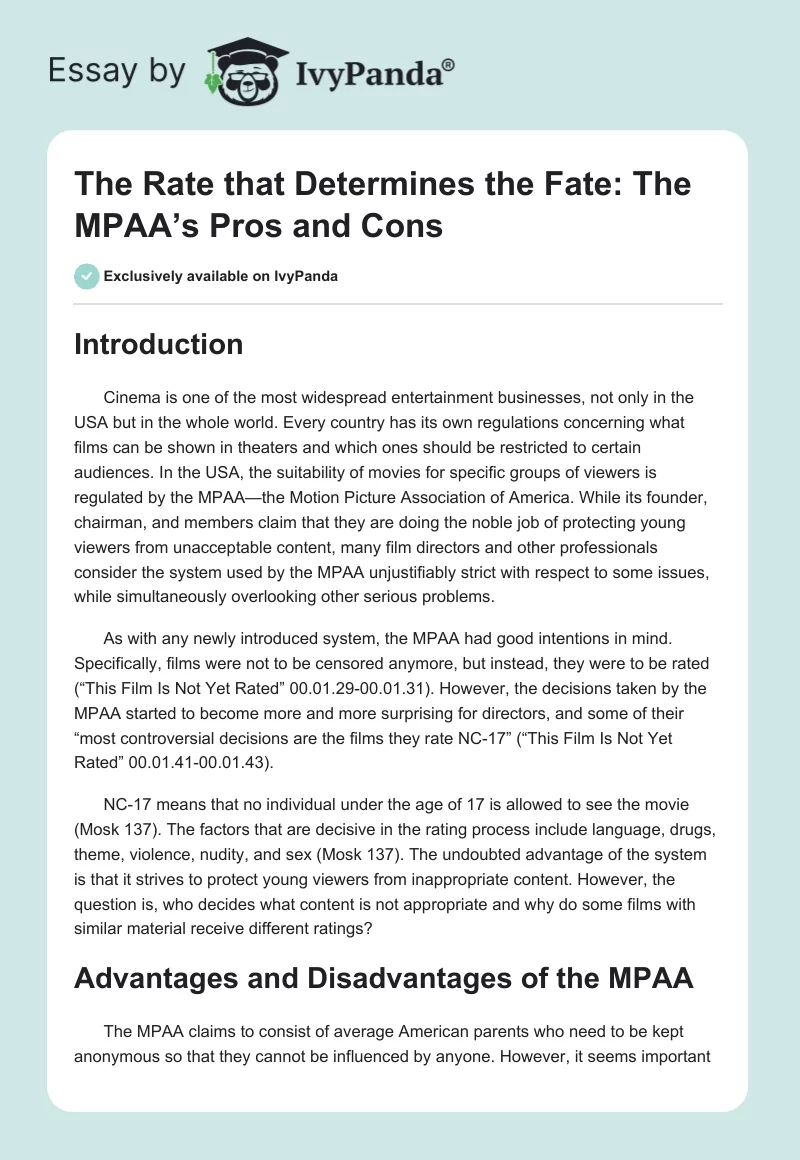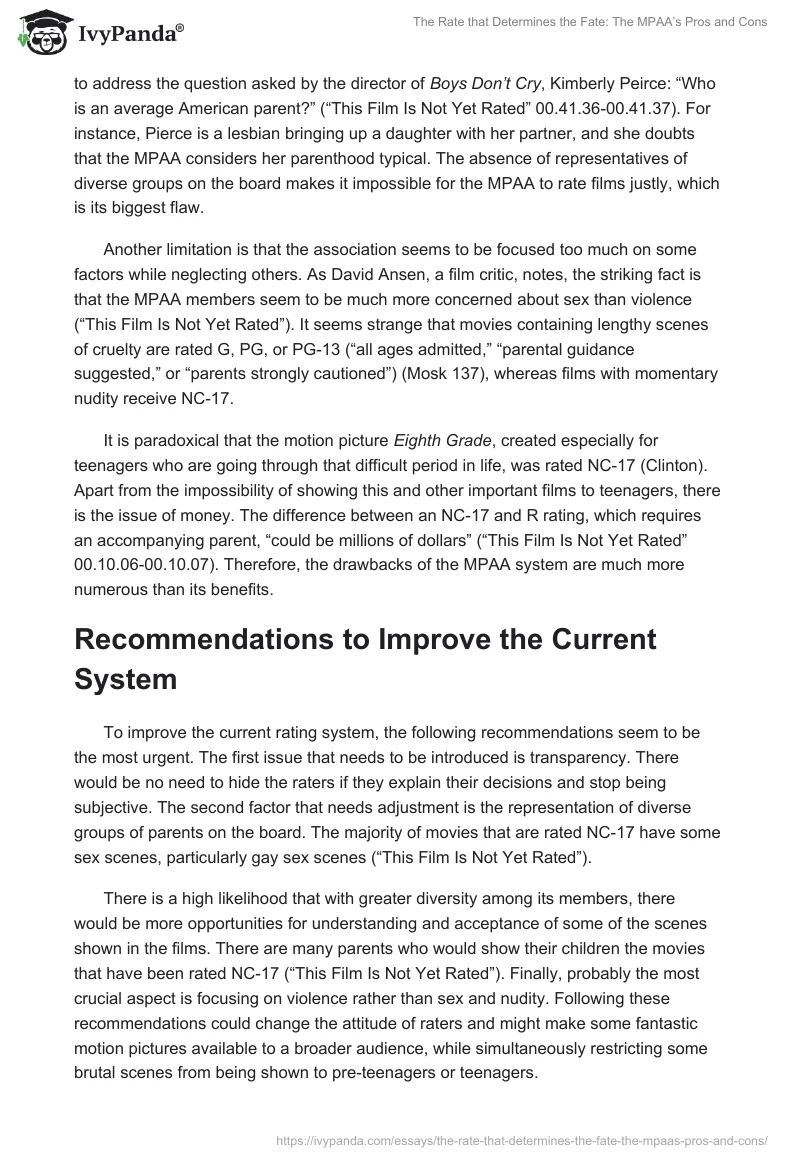Introduction
Cinema is one of the most widespread entertainment businesses, not only in the USA but in the whole world. Every country has its own regulations concerning what films can be shown in theaters and which ones should be restricted to certain audiences. In the USA, the suitability of movies for specific groups of viewers is regulated by the MPAA—the Motion Picture Association of America. While its founder, chairman, and members claim that they are doing the noble job of protecting young viewers from unacceptable content, many film directors and other professionals consider the system used by the MPAA unjustifiably strict with respect to some issues, while simultaneously overlooking other serious problems.
As with any newly introduced system, the MPAA had good intentions in mind. Specifically, films were not to be censored anymore, but instead, they were to be rated (“This Film Is Not Yet Rated” 00.01.29-00.01.31). However, the decisions taken by the MPAA started to become more and more surprising for directors, and some of their “most controversial decisions are the films they rate NC-17” (“This Film Is Not Yet Rated” 00.01.41-00.01.43).
NC-17 means that no individual under the age of 17 is allowed to see the movie (Mosk 137). The factors that are decisive in the rating process include language, drugs, theme, violence, nudity, and sex (Mosk 137). The undoubted advantage of the system is that it strives to protect young viewers from inappropriate content. However, the question is, who decides what content is not appropriate and why do some films with similar material receive different ratings?
Advantages and Disadvantages of the MPAA
The MPAA claims to consist of average American parents who need to be kept anonymous so that they cannot be influenced by anyone. However, it seems important to address the question asked by the director of Boys Don’t Cry, Kimberly Peirce: “Who is an average American parent?” (“This Film Is Not Yet Rated” 00.41.36-00.41.37). For instance, Pierce is a lesbian bringing up a daughter with her partner, and she doubts that the MPAA considers her parenthood typical. The absence of representatives of diverse groups on the board makes it impossible for the MPAA to rate films justly, which is its biggest flaw.
Another limitation is that the association seems to be focused too much on some factors while neglecting others. As David Ansen, a film critic, notes, the striking fact is that the MPAA members seem to be much more concerned about sex than violence (“This Film Is Not Yet Rated”). It seems strange that movies containing lengthy scenes of cruelty are rated G, PG, or PG-13 (“all ages admitted,” “parental guidance suggested,” or “parents strongly cautioned”) (Mosk 137), whereas films with momentary nudity receive NC-17.
It is paradoxical that the motion picture Eighth Grade, created especially for teenagers who are going through that difficult period in life, was rated NC-17 (Clinton). Apart from the impossibility of showing this and other important films to teenagers, there is the issue of money. The difference between an NC-17 and R rating, which requires an accompanying parent, “could be millions of dollars” (“This Film Is Not Yet Rated” 00.10.06-00.10.07). Therefore, the drawbacks of the MPAA system are much more numerous than its benefits.
Recommendations to Improve the Current System
To improve the current rating system, the following recommendations seem to be the most urgent. The first issue that needs to be introduced is transparency. There would be no need to hide the raters if they explain their decisions and stop being subjective. The second factor that needs adjustment is the representation of diverse groups of parents on the board. The majority of movies that are rated NC-17 have some sex scenes, particularly gay sex scenes (“This Film Is Not Yet Rated”).
There is a high likelihood that with greater diversity among its members, there would be more opportunities for understanding and acceptance of some of the scenes shown in the films. There are many parents who would show their children the movies that have been rated NC-17 (“This Film Is Not Yet Rated”). Finally, probably the most crucial aspect is focusing on violence rather than sex and nudity. Following these recommendations could change the attitude of raters and might make some fantastic motion pictures available to a broader audience, while simultaneously restricting some brutal scenes from being shown to pre-teenagers or teenagers.
Prospects of Rating for This Film Is Not Yet Rated
The movie This Film Is Not Yet Rated would be treated differently under the new and improved system from how it was handled by the MPAA. The major reason is that there would be less strict requirements concerning sex and nudity. Also, since the new system would focus more on violence, and the film does not contain many violent scenes, it would be easier for the film to receive at least an R, if not PG-13.
Conclusion
The founder of the MPAA might have had a noble aim in mind when he was launching the rating system for films. However, this regulatory board has numerous shortcomings that have a negative effect on film directors and prevent audiences from seeing high-quality movies. It is possible to improve the current MPAA system by introducing transparency, increasing the diversity of its members, and shifting its primary focus from sex and nudity to violence. If these recommendations are taken into consideration, the decisions of the MPAA will be more justified and relevant.
Works Cited
Clinton, Alexandra. “Bo Burnham Refused to Edit R-rated “Eighth Grade” into PG-13 and Advises Teenagers to “Sneak In”.” Salon. 2018. Web.
Mosk, Richard M. “Motion Picture Ratings in the United States.” Cardozo Arts and Entertainment Law Journal, vol. 15, no. 135, 1997, pp. 135-145.
“This Film Is Not Yet Rated.” YouTube, uploaded by Karl Hungus, 2018. Web.


